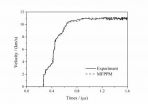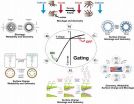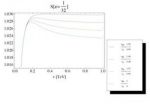(Press-News.org) Biological membranes are like a guarded border. They separate the cell from the environment and at the same time control the import and export of molecules. The nuclear membrane can be crossed via many tiny pores. Scientists at the Biozentrum and the Swiss Nanoscience Institute at the University of Basel, together with an international team of researchers, have discovered that proteins found within the nuclear pore function similar to a velcro. In Nature Nanotechnology, they report how these proteins can be used for controlled and selective transport of particles.
There is much traffic in our cells. Many proteins, for example, need to travel from their production site in the cytoplasm to the nucleus, where they are used to read genetic information. Pores in the nuclear membrane enable their transport into and out of the cell nucleus. The Argovia Professor Roderick Lim, from the Biozentrum and the Swiss Nanoscience Institute at the University of Basel, studies the biophysical basics of this transport. In order to better understand this process, he has created an artificial model of the nuclear pore complex, together with scientists from Lausanne and Cambridge, which has led to the discovery that its proteins function like a nanoscale "velcro" which can be used to transport tiniest particles.
"Dirty velcro" inside the nuclear pore
Nuclear pores are protein complexes within the nuclear membrane that enables molecular exchange between the cytoplasm and nucleus. The driving force is diffusion. Nuclear pores are lined with "velcro" like proteins. Only molecules specially marked with import proteins can bind to these proteins and thus pass the pore. But for all non-binding molecules the nuclear pore acts as a barrier. The researchers postulated that transport depends on the strength of binding to the "velcro" like proteins. The binding should be just strong enough that molecules to be transported can bind but at the same time not too tight so that they can still diffuse through the pore.
In an artificial system recreating the nuclear pore, the researchers tested their hypothesis. They coated particles with import proteins and studied their behavior on the molecular "velcro". Interestingly, the researchers found parallels in behavior to the velcro strip as we know it. On "clean velcro", the particles stick immediately. However, when the "velcro" is filled or "dirtied" with import proteins, it is less adhesive and the particles begin to slide over its surface just by diffusion. "Understanding how the transport process functions in the nuclear pore complex was decisive for our discovery," says Lim. "With the nanoscale 'velcro' we should be able to define the path to be taken as well as speed up the transport of selected particles without requiring external energy."
Potential lab-on-a-chip technology applications
Lim's investigations of biomolecular transport processes form the basis for the discovery of this remarkable phenomenon that particles can be transported selectively with a molecular "velcro". "This principle could find very practical applications, for instance as nanoscale conveyor belts, escalators or tracks," explains Lim. This could also potentially be applied to further miniaturize lab-on-chip technology, tiny labs on chips, where this newly discovered method of transportation would make today's complex pump and valve systems obsolete.
INFORMATION:
Original source
Kai D. Schleicher, Simon L. Dettmer, Larisa E. Kapinos, Stefan Pagliara, Ulrich F. Keyser, Sylvia Jeney and Roderick Y.H. Lim
Selective Transport Control on Molecular Velcro made from Intrinsically Disordered Proteins
Nature Nanotechnology; published online 15 June 2014 | doi: 10.1038/nnano.2014.103
Nanoscale velcro used for molecule transport
2014-06-25
ELSE PRESS RELEASES FROM THIS DATE:
Invisibility cloak for immune cells
2014-06-25
This news release is available in German. The human immune system is very complex. A large number of different cells with various functions ensure that invading microorganisms such as viruses or bacteria can quickly be rendered innocuous and the entire organism stays healthy.
The immune system also includes natural killer cells (NK cells), which recognise and eliminate tumour or virus-infected cells. NK cells therefore combat the body's own stressed cells to prevent them from becoming a potential hazard. However, this bears its risks. Other immune cells, the specific ...
The breakthrough of hypervelocity launch performed on 3-stage light gas gun in CAEP
2014-06-25
In the past 20 years, the Laboratory for Shock Wave and Detonation Physics Research in Institute of Fluid Physics (IFP), China Academy of Engineering Physics (CAEP) has conducted the research in hypervelocity launch technology. The State Key Laboratory of Advanced Technology for Materials Synthesis and Processing of Wuhan University of Technology participated in the research as a cooperator, and took charge of the flier processing. In this project, significant progresses have been made in optimization of the physical design, material processing and experimental measurement ...
Smart gating nanochannels for confined water developed by CAS researchers
2014-06-25
Confined water exists widely and plays important roles in natural environments, particularly inside biological nanochannels. Professor Lei Jiang and his group from State Key Laboratory of Organic Solids, Institute of Chemistry, Chinese Academy of Sciences, set out to study this unified bionic frontier. After several years of innovative research, they developed a series of biomimetic nanochannels, delivered a strategy for the design and construction of smart nanochannels and applied the nanochannels in energy conversion systems. The author thought the inner surface property ...
Recent progress in whole-lifecycle software architecture modeling
2014-06-25
The gradually increasing complexity of user requirements and runtime environments of software demands software to be of more capabilities and thus become more complex than ever. In the past several decades, there was a trend that the scale of software has been increasing continuously. Nowadays, there are tens or even hundreds of million lines of code in a large scale software system. For example, the Windows operating system scales from 15 million lines of code in 1995 to 60 million lines of code in 2007; in 2011, the scale of software in BMW 7 Series reaches 200 million ...
Street football boosts fitness and health in socially deprived men
2014-06-25
Research carried out by the Copenhagen Centre for Team Sport and Health in Denmark shows that street football (soccer) improves fitness and multiple health markers in homeless men. After only 12 weeks, the participants had better postural balance and higher muscle mass and bone mineralization, along with lower fat percentage and LDL cholesterol and higher aerobic fitness and exercise capacity.
Sixteen original scientific articles about the health effects of football were published on June 19 in the Scandinavian Journal of Medicine & Science in Sports. One of these articles ...
Evidence of the big fix?
2014-06-25
There are many open questions that the Standard Model cannot answer. One of them is the smallness of the Higgs expectation value vh compared with the Planck scale. In their latest work, Dr Yuta Hamada, Dr Hikaru Kawai and Dr Kiyoharu Kawana at Kyoto University, consider the radiation S of the universe at the late stage as a function of vh, and they show that S reaches its maximum around the observed value vh = 246 GeV.
"If we demand that S should be maximized, this conclusion can be the explanation to the above question. The main contribution to S comes from the decay ...
Master regulator of key cancer gene found, offers new drug target
2014-06-25
MINNEAPOLIS/ST. PAUL (June 23, 2014) – A key cancer-causing gene, responsible for up to 20 percent of cancers, may have a weak spot in its armor, according to new research from the Masonic Cancer Center, University of Minnesota.
The partnership of MYC, a gene long linked to cancer, and a non-coding RNA, PVT1, could be the key to understanding how MYC fuels cancer cells. The research is published in the latest issue of the journal Nature.
"We knew MYC amplifications cause cancer. But we also know that MYC does not amplify alone. It often pairs with adjacent chromosomal ...
Brewing yeasts reveal secrets of chromosomal warfare and dysfunction
2014-06-25
SEATTLE –Using two yeasts that have been used to brew tea and beer for centuries, researchers at Fred Hutchinson Cancer Research Center have revealed how reproductive barriers might rapidly arise to create species boundaries. Schizosaccharomyces pombe has been used to brew beer in Africa, whereas its close relative S. kombucha is a component of kombucha tea commonly found in health-food stores.
A team of researchers led by Dr. Sarah Zanders of the Basic Sciences Division at Fred Hutch, has uncovered why hybrids between these yeasts (commonly referred to as fission yeasts) ...
3-D computer model may help refine target for deep brain stimulation therapy for dystonia
2014-06-25
LOS ANGELES (June 24, 2014) – Although deep brain stimulation can be an effective therapy for dystonia – a potentially crippling movement disorder – the treatment isn't always effective, or benefits may not be immediate. Precise placement of DBS electrodes is one of several factors that can affect results, but few studies have attempted to identify the "sweet spot," where electrode placement yields the best results.
Researchers led by investigators at Cedars-Sinai, using a complex set of data from records and imaging scans of patients who have undergone successful DBS ...
First comprehensive pediatric concussion guidelines, available now
2014-06-25
Ottawa/Toronto, CANADA – June 25, 2014 – Pediatric emergency medicine researchers at the Children's Hospital of Eastern Ontario (CHEO) together with the Ontario Neurotrauma Foundation (ONF) today launch the first comprehensive pediatric concussion guidelines.
"There have been recommendations and policies on concussion available in the past, but they tend to have focused on sports-related injury and not on children and youth," said Dr. Roger Zemek, project leader, scientist at CHEO, and Assistant Professor of Pediatrics and Emergency Medicine at the University of Ottawa. ...



